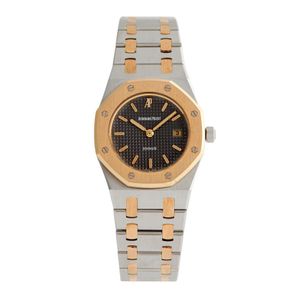AP Royal Oak Ladies Steel and Gold Bracelet Watch
Audemars Piguet Royal oak a lady's stainless steel and gold bracelet watch with date circa 1995. Dial: grey grid, applied baton hour markers, date aperture at 3,. Calibre: cal. 2150 automatic winding, fully jewelled. Case: brushed and polished tonneau form, 18ct gold bezel with eight screws, no. 955. Case number: D51601. Closure: Audemars Piguet fitted brushed and polished stainless steel and 18ct gold link and folding clasp. Dimensions: 30 mm diameter, bracelet circumference approximately 179 mm. Signed: case, dial and movement. Accessories: Audemars Piguet service invoice dated 22 December 2021 and case.
You must be a subscriber, and be logged in to view price and dealer details.
Subscribe Now to view actual auction price for this item
When you subscribe, you have the option of setting the currency in which to display prices to $Au, $US, $NZ or Stg.
This item has been sold, and the description, image and price are for reference purposes only.
- Circa - A Latin term meaning 'about', often used in the antique trade to give an approximate date for the piece, usually considered to be five years on either side of the circa year. Thus, circa 1900 means the piece was made about 1900, probably between 1895 and 1905. The expression is sometimes abbreviated to c.1900.
- Date Aperture - A date aperture is a cut out section in the face of a watch or clock, displaying the day of the month.
- Oak - Native to Europe and England, oak has been used for joinery, furniture and building since the beginning of the medieval civilisation. It is a pale yellow in colour when freshly cut and darkens with age to a mid brown colour.
Oak as a furniture timber was superceded by walnut in the 17th century, and in the 18th century by mahogany,
Semi-fossilised bog oak is black in colour, and is found in peat bogs where the trees have fallen and been preserved from decay by the bog. It is used for jewellery and small carved trinkets.
Pollard oak is taken from an oak that has been regularly pollarded, that is the upper branches have been removed at the top of the trunk, result that new branches would appear, and over time the top would become ball-like. . When harvested and sawn, the timber displays a continuous surface of knotty circles. The timber was scarce and expensive and was used in more expensive pieces of furniture in the Regency and Victorian periods. - Bezel - On a clock or watch, the bezel is the metal frame into which the watch or clock glass is fitted. In clocks, the bezel may include a hinge and a flange, in effect a door to the face of the clock. In jewellery the bezel is a band of metal with a projecting lip that holds the gemstone in its setting.
- Movement - The technical name for the workings of a clock or watch, and does not include the dial or case.
This item has been included into following indexes:
